Key Points
- There are more than 50 types of snakes in Mississippi and six of them are venomous.
- It’s important to practice caution any time you come across a snake until you are sure of what type it is.
- You should focus on learning how to identify the six venomous snakes first to protect yourself.
Mississippi is known for many things, including having some of the most beautiful state parks in the country. There are 25 state parks throughout Mississippi.
While most people think of Mississippi as being flat grassland, the state sits at the foot of the Appalachian mountains so there are forests, mountains, hills, lakes, and of course, the Mississippi River that gives Mississippi a lot of variation.
Another thing worth mentioning is that there are a lot of snakes in Mississippi. There are more than 50 different types of Mississippi snakes and six of them are venomous. So if you’re planning on enjoying some outdoor activities in Mississippi you will need to keep an eye on the ground to watch out for snakes.
Non-venomous Snakes in Mississippi
Many of the different varieties of Mississippi snakes are similar to other types of snakes and may just have different coloring or prefer to live in a different habitat. That’s one of the reasons why it’s important to know how to identify the many different types of snakes in Mississippi.
Since a whopping six types of snakes in Mississippi are venomous it’s a good idea to practice caution anytime you see a snake in Mississippi until you are sure what type of snake it is. Some of the most common non-venomous snakes in Mississippi are:
Midwest Worm Snake
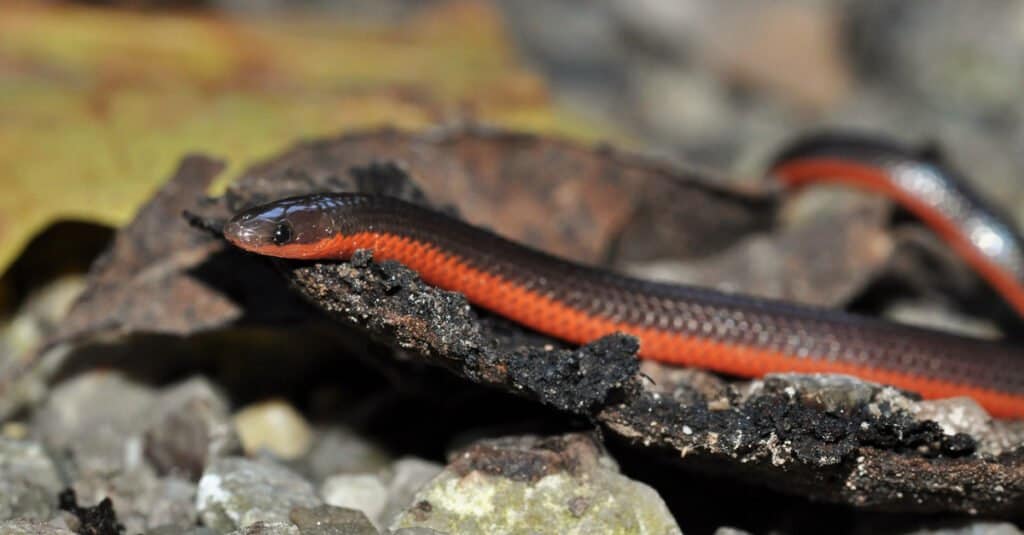
Worm snakes are small and prefer avoiding contact with humans.
©Mike Wilhelm/Shutterstock.com
Midwest worm snakes are so small that you might not even notice them at first. They rarely grow to be more than a foot long and most of them are only about six inches long. These snakes typically are a dull gray with a pink or reddish belly.
They tend to stay in the wooded areas near streams and lakes but they also sometimes live in the rocky areas bordering grasslands. These small snakes are harmless to humans. They dig under the dirt to find earthworms and other prey and they like to stay hidden. If you do happen to see one it will likely move along as quickly as possible.
Northern Scarlet Snake
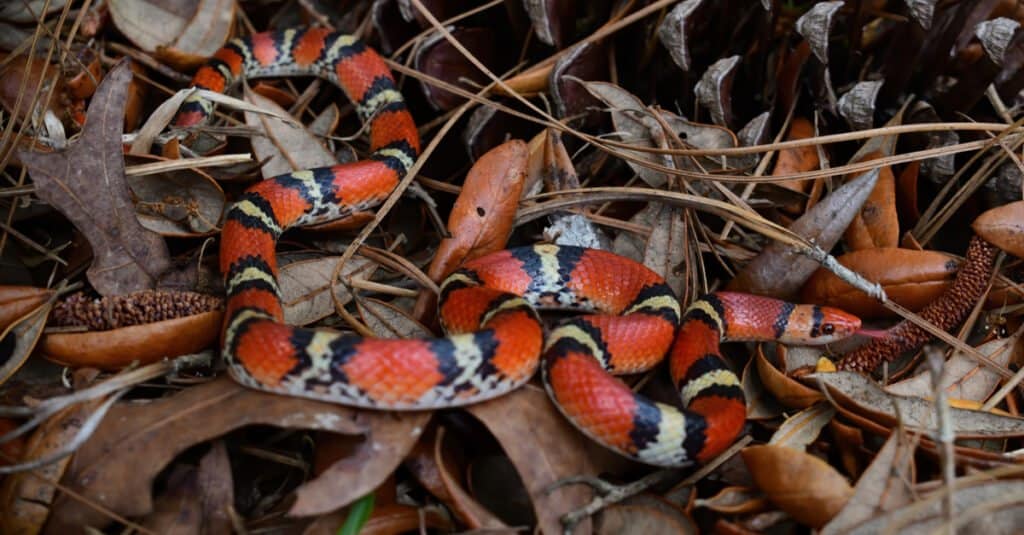
Scarlet snakes are nonvenomous snakes.
©Chase D’animulls/Shutterstock.com
The northern scarlet snake is easy to identify thanks to the very wide bands of red scales on its back. Each wide red band is bordered on either side by narrow bands of black with yellow. The northern scarlet snake has a pink or light red belly but you will probably not get a chance to see the belly of this snake.
These snakes prefer to burrow into soft sandy soil but they can also be found in trash piles, under rocks, under dirt piles, under mulch, and in other areas where they can hide. Because this snake likes sandy soil you may find them in your garden or near your garage in a suburban area but don’t worry, they’re not venomous.
Black Kingsnake

Black kingsnakes will actually hunt venomous snakes and can be beneficial.
©Matt Jeppson/Shutterstock.com
If you see a black kingsnake don’t be afraid of it, these snakes only look scary. Their dark black scales and wide body make this snake intimidating but black kingsnakes can actually be very beneficial to have around. In addition to eating vermin and rodents, they are not affected by the venom of rattlesnakes and other venomous snakes.
They often prey on venomous snakes which can help protect you from venomous snakes. Black kingsnakes are often only about five feet long but they have wide heavyset bodies because they kill prey by constricting.
Gulf Salt Marsh Snake
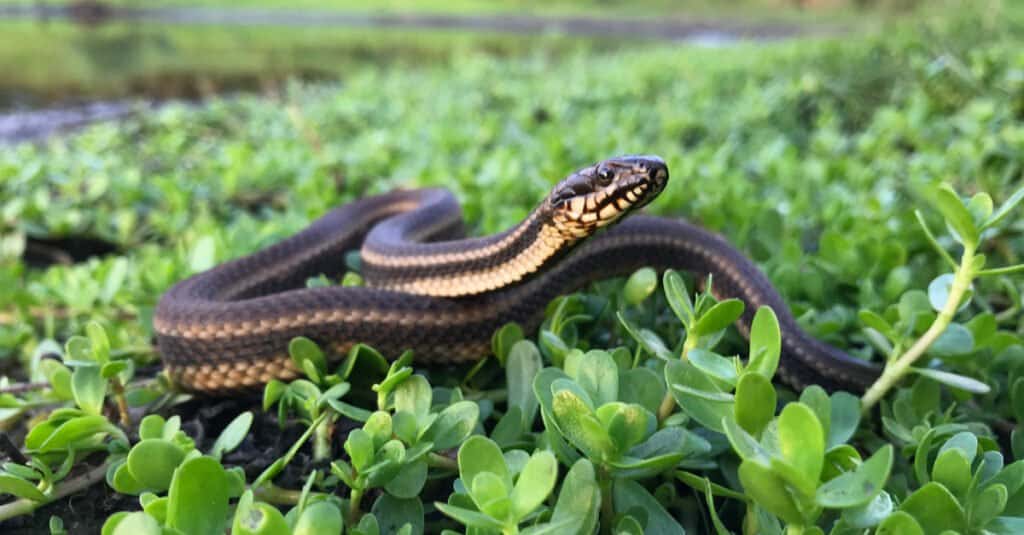
Gulf marsh snakes are most commonly found in aquatic environments near the Gulf Coast
©Joe Farah/Shutterstock.com
As you may have guessed from the name this snake is primarily found near the Gulf waters and in other salt marshes or swampy areas. It also sometimes lives on barrier islands. These unique snakes generally are only a foot to a foot and a half long but they have a very distinctive gray base color with a distinctive pattern of four black stripes.
Gulf salt marsh snakes are non-threatening and will ignore people most of the time. However, if you try to handle one it may strike out or bite you.
Delta Glossy Swamp Snake (Crayfish Snake)

Delta glossy swamp
snakes live
in marshlands across the Gulf Coast.
©Rusty Dodson/Shutterstock.com
The delta glossy swamp snake is also sometimes called the crayfish snake since it primarily eats crayfish. This snake has a dull mud-colored base color so that it blends into the swampy marshlands where it prefers to live. The Delta Glossy Swamp snake can be found throughout the Mississippi, Louisiana, and Florida region where it lives in the low-lying swamps that are scattered throughout the states. They are very small and tend to be about a foot long, although they can grow up to about 16 inches long.
Corn Snake

©Photohobbiest/Shutterstock.com
The corn snake is native to the southeastern region of the US and often resides in large fields, tall trees, forest openings, and abandoned or empty buildings. The corn snake is thought to have gotten its name either from its bright orange and red patterns that resemble corn or from the fact that it is often found near grain stores. Corn snakes are similar to rat snakes in that they keep the vermin population in check, while also feeding on bird eggs, amphibians, and other reptiles. They are harmless to humans, and corn snakes are often kept as exotic pets because they are easy to handle and come in an array of interesting skin patterns. An adult can range in size from 4-6 feet long and have a diameter of an inch.
Venomous Snakes In Mississippi
Mississippi has a high number of venomous snakes, six different kinds in total. Venomous snakes in Mississippi that you should watch out for are:
Southern Copperhead
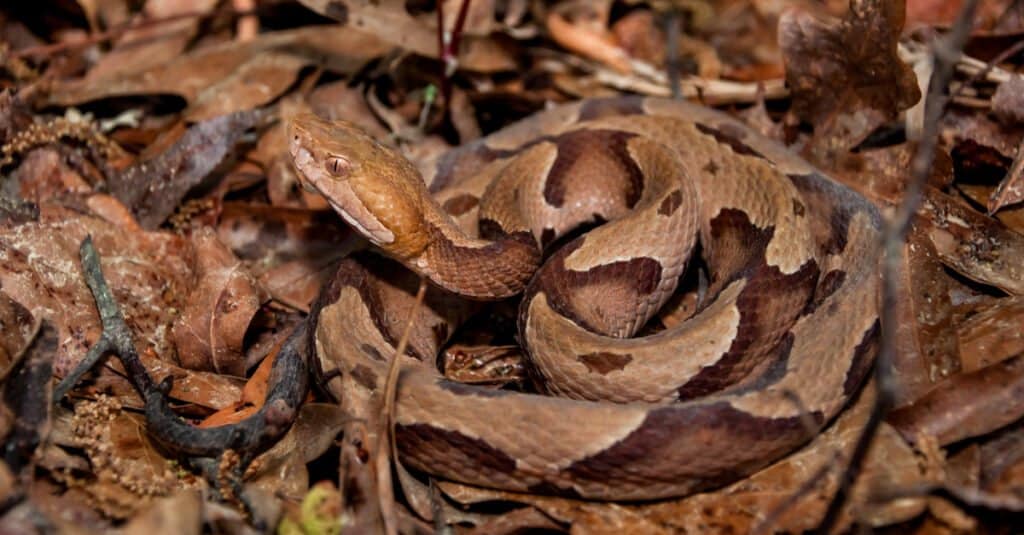
Southern copperheads bled in with their environment and should be avoided.
©Jay Ondreicka/Shutterstock.com
The Southern Copperhead likes to hide near the base of trees, in piles of brush, or next to large rocks. The unique color patterns this snake has been designed to help it stay hidden so you may not see the Southern Copperhead until you are very close to it. These snakes are highly venomous. They would rather flee than fight but if you surprise it or are too close it might feel threatened and strike. If you come across one of these snakes hold very still and don’t make any sudden movements. Instead, move very slowly and back up until you are out of the snake’s strike range. Most of the time as soon as you give it a little space they will slither away. Southern Coppherheads are found throughout Mississippi aside from small portions of the Gulf Coast.
Cottonmouth Snakes (Western and Northern)

Cottonmouth snakes are mostly aquatic.
©Jay Ondreicka/Shutterstock.com
These snakes have different colorations but belong to the same family and both are venomous. They are mostly aquatic and are usually found in salt marshes, swamps, and other low-lying wet environments. While cottonmouths in most of the state have dark brown waves, cottonmouths from the Gulf Coast can be more dark-brown. Cottonmouths have black bars or scales under their mouths but their mouths are white. These snakes have potent venom and can be deadly, so be extremely cautious if you see any snakes that could be Cottonmouths when you are out and about in Mississippi. If startled, cottonmouths will show their white mouth, which often can give time to leave the area of the snake before it resorts to striking.
Eastern Coral Snake

Coral snakes are brightly colored and have distinctive bands
©iStock.com/JasonOndreicka
The eastern coral snake is known for the very vivid stripes that cover its body and for the potency of the venom that it has. These snakes are on the small side, but they’re just as venomous as larger snakes like rattlesnakes. It’s unfortunately easy to mix up a coral snake with a kingsnake because the kingsnake has similar vivid colored stripes. But eastern coral snakes usually don’t have the black borders on the stripes that kingsnakes have. The eastern coral snake prefers to live in sandy soil and in Mississippi, it can be found on sandy ridges and in sandy creek bottoms. The colors of this snake make it tough to miss so if you see it give it a wide berth and try to avoid crossing its path. If you’re in the northern end of Mississippi you won’t find these snakes, they tend to keep to the bottom 1/3 of Mississippi’s area.
Pygmy Rattlesnake (Western and Dusky)
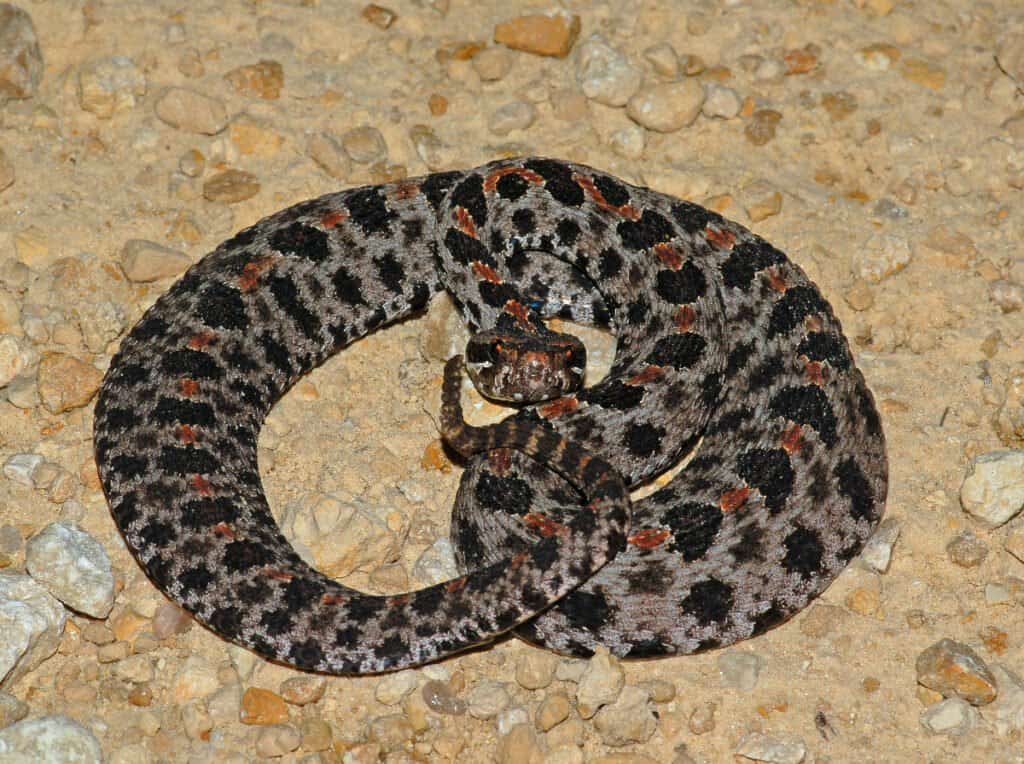
Pygmy rattlesnakes can be found across most of Mississippi aside from the Mississippi river basin.
©Gerald A. DeBoer/Shutterstock.com
The western pygmy rattlesnake typically has a gray body with blotches of color like black or yellow. Like other rattlesnakes, it has a heavy and wide body. But unlike other rattlesnakes, the western pygmy is usually under two feet long and can be just a foot long. Generally, these rattlesnakes avoid people and aren’t aggressive. But any snake can become aggressive if it feels threatened so it’s best to avoid any snake that is rattling or is raising its head and puffing up. These snakes are generally not found near the Mississippi River, but they’ve been found across every other region in the state.
Timber Rattlesnake
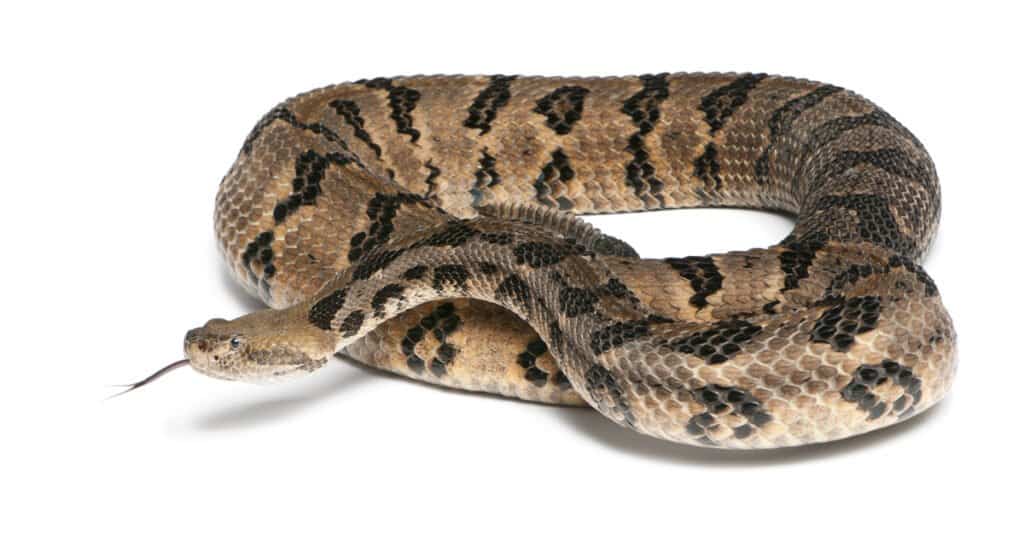
Timber Rattlesnakes
are found across much of the United States
©Eric Isselee/Shutterstock.com
Timber rattlesnakes are 2 to 3 times the size of pygmy rattlesnakes. They can be found across the majority of Mississippi but are not commonly found along the Gulf Coast. Their populations are not quite as numerous as they once were, and these snakes aren’t as aggressive as other venomous snakes in Mississippi. In general, if you avoid timber rattlesnakes they pose little harm.
Eastern Diamondback Rattlesnake
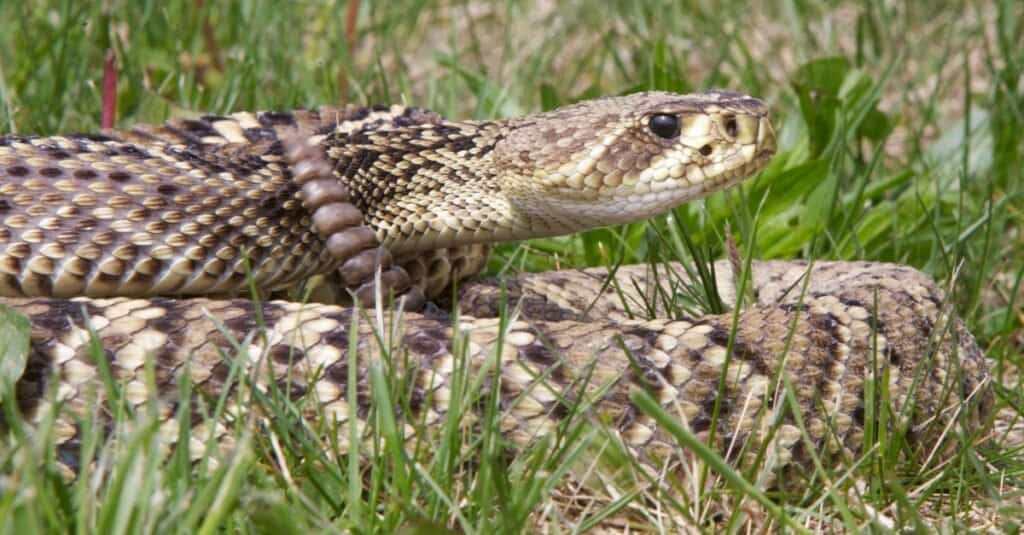
The Eastern diamondback rattlesnake was a symbol on one of the first flags of the United States.
©iStock.com/NajaShots
The eastern diamondback isn’t just the largest venomous snake in Mississippi, it’s the largest rattlesnake in all of North America! The snakes are found from Louisiana to North Carolina but are rarely more than 100 miles from any coastline. In Mississippi, the snakes range up to towns like Brookhaven or Laurel, but not much further north. These snakes blend in well with their environment, but will generally make their presence known before striking. Like the timber rattlesnake, they’re increasingly a rare site due to habitat loss and hunting.
The Complete List of Snakes In Mississippi
There are a lot of snakes in Mississippi so you probably won’t be able to learn to identify them all. But, in general, you should focus on learning how to spot the venomous snakes in Mississippi. That way you can keep yourself safe. However, if you’re in doubt about that type of snake you see when you’re out and come across a snake just stop, move slowly, and back up until you’re out of the snake’s range.
A full list of snakes in Mississippi:
- Southern Copperhead
- Western Cottonmouth
- Northern Cottonmouth
- Eastern Diamondback Rattlesnake
- Timber Rattlesnake
- Eastern Coral Snake
- Dusky Pygmy Rattlesnake
- Western Pygmy Rattlesnake
- Midwest Worm Snake
- Northern Scarlet Snake
- Black-masked Racer
- Southern Black Racer
- Mississippi Ring-necked Snake
- Eastern Indigo Snake
- Western Mud Snake
- Common Rainbow Snake
- Rough Earth Snake
- Eastern Hognose Snake
- Southern Hognose Snake
- Prairie Kingsnake
- Mole Kingsnake
- Peninsula Kingsnake
- Speckled Kingsnake
- Black Kingsnake
- Delta Glossy Swamp Snake
- Gulf Glossy Swamp Snake
- Eastern Coachwhip Snake
- Gulf Saltmarsh Snake
- Mississippi Green Water Snake
- Yellow-bellied Water Snake
- Broad Banded Water Snake
- Banded Water Snake
- Diamond-backed Water Snake
- Midland Water Snake
- Rough Green Snake
- Corn Snake
- Black Rat Snake
- Gray Rat Snake
- Black Pine Snake
- Graham’s Crayfish Snake
- Queen Snake
- Pine Woods Snake
- Midland Brown Snake
- Florida Red-bellied Snake
- Northern Red-bellied Snake
- Southeastern Crowned Snake
- Western Ribbon Snake
- Eastern Ribbon Snake
- Eastern Garter Snake
- Western Smooth Earth Snake
- Eastern Smooth Earth Snake
Please note that you might see lists with different numbers of snakes that live in Mississippi, that’s partially because many snakes have regional subspecies or some species may live along the borders of Mississippi and are only occasional visitors. Regardless of the exact number of snakes in Mississippi just remember the venomous species because they deserve extra care to avoid!
Summary of Snakes in Mississippi
Below is a summary of 12 of the Mississippi snakes highlighted in this article:
| Non-Venomous | Venomous |
|---|---|
| Midwest Worm Snake | Southern Copperhead |
| Northern Scarlet Snake | Cottonmouth Snakes (Western and Northern) |
| Black Kingsnake | Eastern Coral Snake |
| Gulf Salt Marsh Snake | Pygmy Rattlesnake (Western and Dusky) |
| Delta Glossy Swamp Snake (Crayfish Snake) | Timber Rattlesnake |
| Corn Snake | Eastern Diamondback Rattlesnake |
What Animals Are Found in Mississippi?
Mississippi is known for its rich and diverse wildlife populations, which are supported by a range of habitats, including forests, wetlands, and grasslands.
The state is home to many species of mammals, birds, reptiles, amphibians, and fish, and it is a popular destination for outdoor enthusiasts and nature lovers.
Mississippi is home to a variety of wildlife species, including:
- Mammals: White-tailed deer, black bear, raccoon, opossum, squirrel, and armadillo
- Birds: Eastern Wild Turkey, Wood Duck, Red-tailed Hawk, American Goldfinch, Pileated Woodpecker, and Chimney Swift
- Reptiles: Alligator, Diamondback Rattlesnake, Water Moccasin, and Eastern Box Turtle
- Amphibians: American Bullfrog, Green Treefrog, and Spring Peeper
- Fish: Largemouth Bass, Bluegill, and Catfish
This list is not exhaustive, but it gives a good idea of the diverse wildlife that can be found in Mississippi. The state is home to a variety of habitats, including the Mississippi River, which supports many species of fish and waterfowl, as well as the Mississippi Delta, which is home to a large number of species of reptiles and amphibians.
Additionally, the state’s diverse forest and woodland habitats support a range of mammals and birds, making Mississippi a great place for outdoor enthusiasts and nature lovers.
Bonus: Which U.S. State Has the Most Snake Bites?
There’s no denying that there are a whole lotta snakes slithering around in Mississippi. In fact, according to Dr. Bob Galli of the Mississippi Poison Control Center, the average amount of reported snake bites per year in this southern state is 100. Of those, copperhead snakes are responsible for 60%, cottonmouths for 30%, and 10% for various species of rattlesnakes.
But which state ranks the highest in snake bites? That would be North Carolina. The snake bite rate in this southeastern state is 157.8 bites per million population annually. As the population as of 2021 was a little over 10 million (10.55 to be exact), and we were to just figure it off of 10 million, that would average out to roughly 1,580 reported snake bites per year.
The top 6 states for reported snake bites are:
| Rank | State | Bites per Million |
|---|---|---|
| 1 | North Carolina | 157.8 |
| 2 | West Virginia | 105.3 |
| 3 | Arkansas | 92.9 |
| 4 | Oklahoma | 61 |
| 5 | Virginia | 48.7 |
| 6 | Texas | 44.2 |
There are 6 different kinds of venomous snakes inhabiting North Carolina: copperhead, cottonmouth, eastern coral snake, eastern diamondback rattlesnake, pigmy rattlesnake, and timber rattlesnake. In the year 2019, there were 92 people bitten by venomous snakes in that state.
The photo featured at the top of this post is ©
Discover the "Monster" Snake 5X Bigger than an Anaconda
Every day A-Z Animals sends out some of the most incredible facts in the world from our free newsletter. Want to discover the 10 most beautiful snakes in the world, a "snake island" where you're never more than 3 feet from danger, or a "monster" snake 5X larger than an anaconda? Then sign up right now and you'll start receiving our daily newsletter absolutely free.
Thank you for reading! Have some feedback for us? Contact the AZ Animals editorial team.






